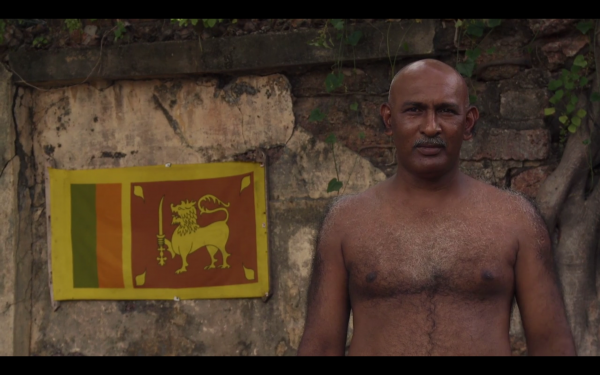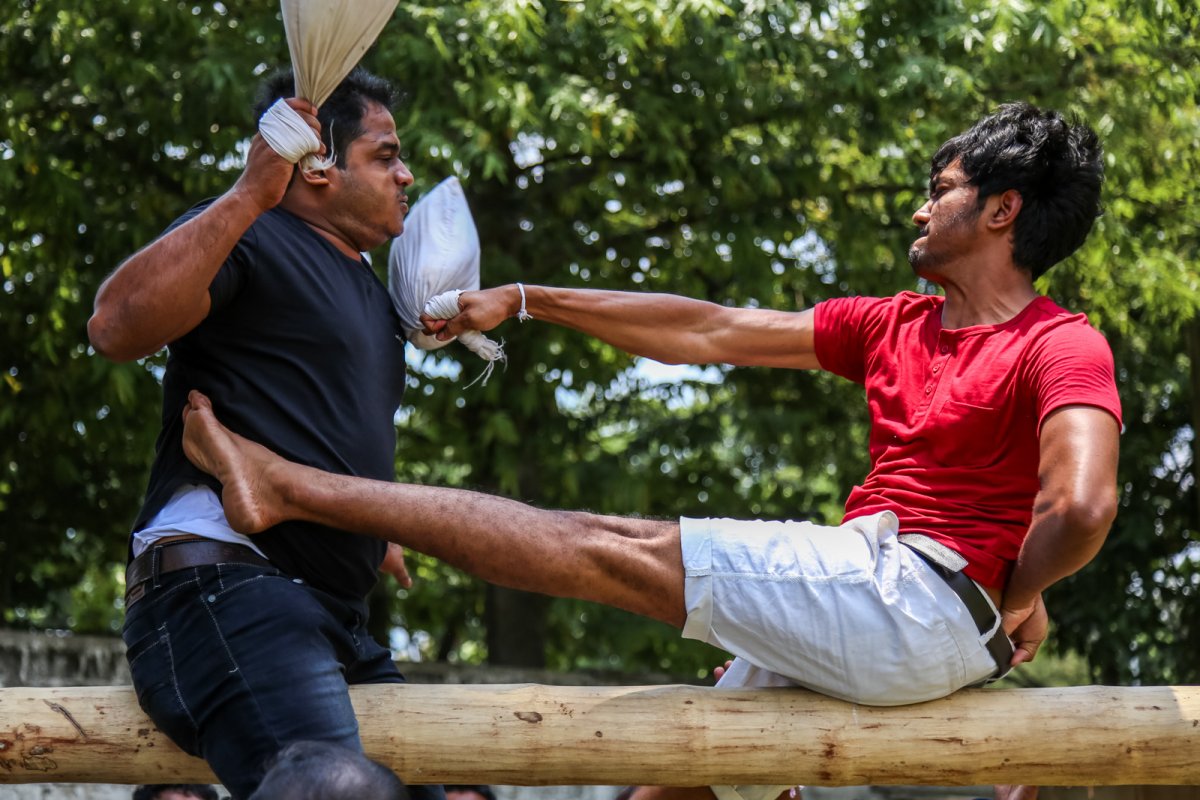
If you are lucky enough to be living on this little tropical island of ours, there is a good chance that you generally look forward to the month of April. Spring is in the air, holidays are around the corner, little wayside boutiques selling crackers seem to sprout everywhere, and there is all that milk rice, kevum, and kokis to anticipate (and it does not matter what ethnicity you belong to either!). But had you lived a few decades ago, or perhaps even in this day and age in a rural village untouched by the unrelenting urbanization, you’d have something else to look forward to as well—all those quirky communal Avurudu games in which you can divest yourself of all inhibitions, throw any harboured ill-feeling out of the window and join the rest of your community in cheerfully throwing coconuts at each other to your heart’s content.
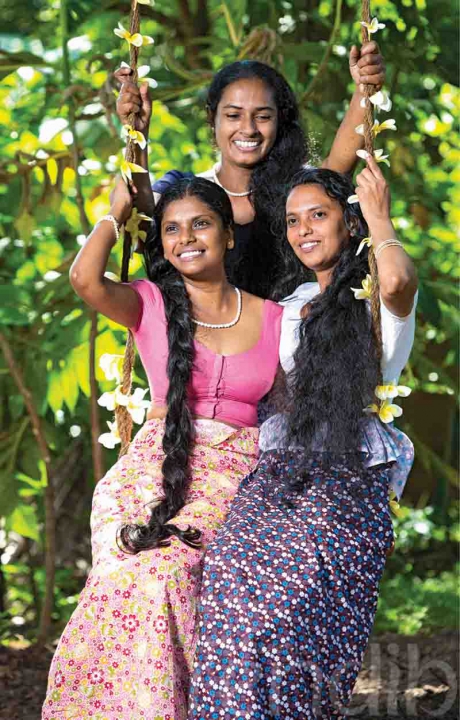
Image courtesy: serendib.btoptions.lk/article
It is not that these games are not around anymore—you can still come across them in abundance every time the April holidays roll around in all those sponsored avurudu-associated corporate and community events, as well as in the rural communities. However, while the more sober customs like anointing the oil, and lighting the fires continue to flow seamlessly from generation to generation, the traditional avurudu games seems to be growing steadily smaller in scale, gradually becoming more commercialized than ritualistic with every new generation. So in the spirit of keeping them alive and recognizing their importance in promoting community spirit, tradition and goodwill, here are five of Sri Lanka’s unconventional outdoor avurudu games and what they are all about.
1 – Kotta Pora
Picture this: a conventional pillow fight. Now throw in a stout horizontal pole, a bound arm, a crowd of cheering onlookers and the risk of falling on your noggin on the hard ground, and you’ve pretty much got the gist of what kotta pora is like.
We Sri Lankans like to go about things in unique ways, and it’s the same for pillow fights. In kotta pora, the two players have to balance themselves on a horizontal bar suspended above the ground with one hand tied behind their backs. The other hand is used to hold the pillow (or a bag stuffed with some soft material) with which each player attempts to knock his opponent off his perch. In some versions of this game, the pole is suspended above a pool or a pond, with the vanquished participant generally ending up pitching unceremoniously into the water.
2 – Ankeliya (tugging the horn)
Many Avurudu games signify more than just fun and frolic, having their roots in astrology, indigenous traditions or Sinhalese and Tamil customs. Ankeliya, for instance, can be considered a fertility rite, conducted on behalf of the Goddess Pattini, the patron deity of fertility and health. In this game, two teams, the uda pila and yata pila (the upper team and lower team) meet at the ang-pitiya (tugging field), which should contain a strong tree (the ang-gaha, or horn tree). Each division has a forked sambur horn or a similar shaped wooden replacement, both of which are interlocked and attached to the tree. The idea of the game is pretty simple; both teams tug at a rope which is fixed to the horns (think tug-o-war with a local twist) until one of the horns is damaged or broken. The team whose horn remains intact is declared the winner!
3 – Kana mutti bindeema (breaking pots)
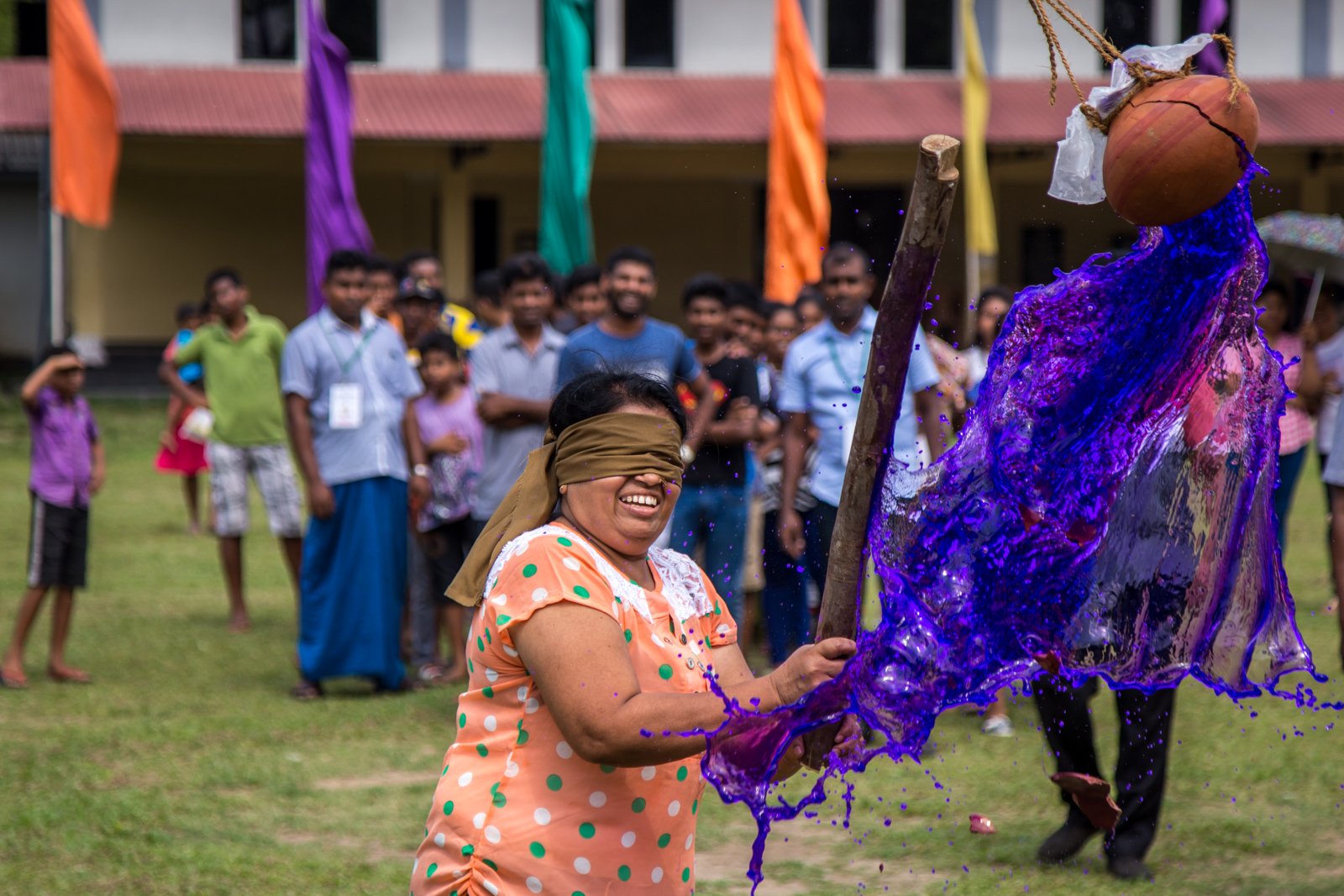
Photo Credits : Nazly Ahmed / Roar Media
We human beings are instilled with certain deep-rooted societal boundaries, and one of the biggest of them is that unwritten law which states: thou shalt not smash things. In this avurudu game, you can throw that inner inhibition out of the window, get yourself a stout pole and join the rest of your fellow revellers in a Sri Lankan version of smash-the-piñata.
In kana mutti bindeema, a row of clay pots containing sand or water are suspended at a certain height. One of the pots—the ‘winning’ pot—contains something different, either an object, or, in most cases, coloured water. The participants are blindfolded, spun around a few times and then handed a bamboo pole. Wild swings and swipes generally elicit cheers and laughter from the watching crowd, especially when the contender ends up getting drenched. The winner, of course, is the person who hits the correct pot.
4 – Porapol Gaseema
This is one of those Avurudu games which has associations with religious tradition. Just like ankeliya, porapol gaseema, or porakeliya is seen as a ritual invoking the blessings of Pattini, and consists of two teams, the uda pila and yata pila. However unlike ankeliya, there is that perpetual risk of being injured by a flying coconut, but hey, that just adds to the excitement of the thing.
In porapol gaseema, the two teams take it turns to throw coconuts at each other. A player from one team hurls a coconut towards the player from another team, who is supposed to block the nutty missile with a coconut of his own. The game continues in this (rather dangerous) vein until most of the coconuts from one team have cracked. The team with the most number of intact nuts is adjudged the winner.
Typically, before the game begins, a kapu mahatthaya invokes divine blessings for the safety of the players, as well as prosperity for the whole community. Still, getting hit in the face with a coconut can’t be a fun experience, so we advise caution if you do not have excellent reflexes and exceptional hand-eye coordination.
5- Lissana gaha nageema (climbing the greasy pole)

Photo Credits : Nazly Ahmed / Roar Media
A long pole, traditionally made from the trunk of an arecanut tree, is stuck vertically into the ground and given a coat of thick slimy grease. A certain object like a flag or, in some instances, a bag of money is placed at the apex. The rest is quite simple—the contestant who actually manages to haul his way up the slippery trunk and obtain the prize at the top is the winner, and gets to walk away with the loot (if there is loot involved). Repeated attempts to climb the pole usually result in the grease wearing off, so it generally gets easier as the game proceeds!
6 – Banis Kaema (bun eating contest)
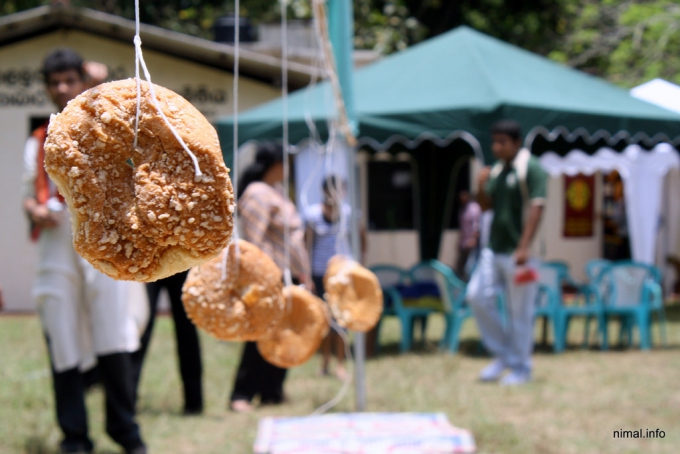
Ready, steady, eat! A row of suspended buns, waiting to be wolfed down by New Year revellers. Image credits flickcr.com/photos/nimal
We Sri Lankans are partial to food. We also love festivity, some healthy (and slightly crazy) competition and good clean fun, so games like banis kaema are right up our alley. This game has no religious or ritualistic connotations whatsoever, and absolutely no astrological significance, but it has evolved into one of those activities which any avurudu ulele could never do without.
In this outdoor activity, a row of buns are suspended from a horizontal pole or string. The contestants line up, kneeling in front of the dangling buns, with their hands tied behind their backs. The objective of the game is to finish the bun as quickly as possible, with the first person to eat the entire bun being declared the winner. It is a good chance to throw table manners to the winds and just gobble as fast as you can for a change, so we can sort of see the attraction of the game.
7 – Gudu Keliya
Unlike kotta pora, which is practically iconic during avurudu season, this is one of the lesser known outdoor games, fast waning into obscurity. More commonly played by young children, the game requires nothing but two sticks—a short one of about 6 inches in length and a longer one of about two and a half feet in length—and a small hole in the ground. The shorter stick, known as the kuttiya, is placed across the hole, while the longer one is inserted underneath. The objective of the game is for the the striker to propel the kuttiya upwards as high as they can, while the rest of the players, spread out across the playing field, attempt to catch it. If the kuttiya is caught, the striker loses the game.
Most avurudu activities are designed to cater to the farming communities and, so they are uncomplicated, unfussy and make use of props which are both simple and easily accessible. However, it is the pure simplicity of these games which make them so enjoyable—there is no vindictive competition, no urge to win; it is simply a chance to divert from the usual daily grind and come together as a community, to just whack each other with pillows or get drenched after smashing up a clay pot. In this day and age, most holidays and festivals are so commercialised that they are often in danger of becoming celebrations of great shopping deals rather than age-old traditions. Here’s to hoping that our traditional New Year celebrations live on for generations to come; the world would be a lot duller without a good bout of kotta pora to look forward to!





